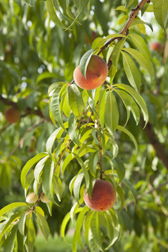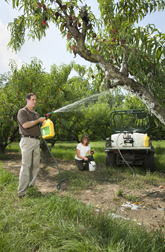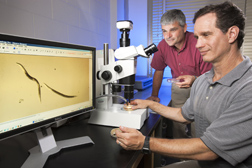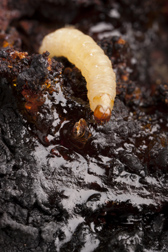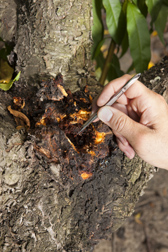“Fire Gel” Protects Beneficial Nematodes From Sun
|
|
The Steinernema carpocapsae nematode is a little worm that can protect peach and other stone fruit trees by attacking devastating borer pests. Some nematodes are pests, but these are beneficial because they can act as biological controls of the borers and other insect pests.
Trouble is, this nematode is sensitive to the sun’s harmful ultraviolet rays and heat, both of which can cause desiccation—the state of extreme dryness. In time this can cause death, so the nematodes could benefit from some sort of protection when exposed to these elements.
Agricultural Research Service scientists in Byron, Georgia, are trying a novel approach to help the tiny worms. They’re testing the same type of “fire gel” that has been used to help prevent the spread of fire to residential and commercial structures to see whether the gel, after it is sprayed onto fruit trees, can help nematodes avoid desiccation.
The gel creates a barrier between the fire and the structure it’s protecting, preventing the spread of fire. This barrier property could also serve as a moisture “blanket” for nematodes, allowing them to attack pests above ground without being harmed by the sun.
There are two species of borers that attack peaches—lesser peachtree borers, which attack the aboveground portions of the peach tree, and peachtree borers (also known as greater peachtree borers), which attack the roots of the tree. In laboratory settings, S. carpocapsae nematodes proved effective in killing both borer species.
The nematodes are efficient at controlling the underground-dwelling peachtree borer but lose their effectiveness above ground. That’s because the nematodes’ chances of survival are far greater below ground—where the soil’s moisture helps them stave off drying—than above ground, where they’re exposed to sun and heat.
According to entomologist David Shapiro-Ilan, with ARS’s Southeastern Fruit and Tree Nut Research Laboratory in Byron, “If fire gels can protect a house, they may be able to protect nematodes for a few days so that they can kill the lesser peachtree borer.”
And he’s shown that the gel does just that. Shapiro-Ilan, along with fellow Byron entomologist Ted Cottrell, tested different formulations aimed at protecting the nematodes during aboveground application, including the fire gel.
After 2 years of testing, a nontoxic, environmentally friendly brand of fire gel (Barricade) was the most effective treatment. The best part was that the gel-nematode combination left only 30 percent of the lesser peachtree borers alive in 2008 (from 100 percent initial survival), and none survived in 2009.
The scientists believe the sprayable gel could be used to protect other beneficial species besides S. carpocapsae. The gel might be used in combination with other beneficial nematodes to control a wide range of pests in trees or other crops above ground.
Shapiro-Ilan and Cottrell received funding from a U.S. Department of Agriculture Pest Management Alternatives Program and collaborated with entomologists Dan Horton at the University of Georgia and Russ Mizell at the University of Florida.
The scientific team plans to test the fire gel on grower orchards. Horton, who also serves as an extension specialist, will be instrumental in finding these grower cooperators. Horton is developing an instructional video offering farmers tips on how best to apply the gel. Mizell will conduct field trials in Quincy, Florida, to determine the best time of year to apply the gel and to see whether Shapiro-Ilan’s technology is applicable in that region.
Shapiro-Ilan is also working with ARS collaborators Bob Behle and Chris Dunlap in Peoria, Illinois, as well as Lerry Lacey in Wapato, Washington. Behle, an entomologist, and Dunlap, a chemist, specialize in formulation of microbial agents and have provided Shapiro-Ilan with some of the ingredients needed for his field trials.
Lacey, an entomologist, has developed a foam formulation that consists of wood fiber, wood flour, and starch. This formulation forms a protective crust, whereas the gel is sticky.
|
|
Shapiro-Ilan has tested the two formulations—gel and foam—and found that the gel worked best for borers in the southeast, possibly due to the hot, dry climate. Lacey found that the foam worked better in the wet, cool northwest, protecting nematodes that attack the codling moth, a destructive pest of apples and pears. Shapiro-Ilan and Lacey will continue to test the formulations under a variety of conditions.
The scientific team is researching how to further optimize application rates and timing and to perform large farm-scale tests using air-blast sprayers to apply the fire gel. The scientists will also test air handgun sprayers, which efficiently disperse the fire gel in a uniform spray pattern. Additional laboratory tests are being conducted in search of superior nematode strains.
|
|
“We’re going to test how much and how often we’d like to disperse the fire gel through these means,” said Shapiro-Ilan, who plans to work with small and organic growers first and continue with large-scale growers in the next few years. “We’d like to make this process as efficient and economical as possible so we can get the most bang for our buck. Growers are savvy enough that if something makes economic sense, they’re going to do it.”—By Alfredo Flores, formerly with ARS.
This research is part of Crop Protection and Quarantine, an ARS national program (#304) described at www.nps.ars.usda.gov.
David I. Shapiro-Ilan and Ted Cottrell are at the USDA-ARS Southeastern Fruit and Tree Nut Research Laboratory, 21 Dunbar Road, Byron, GA 31008; (478) 956-6444 [Shapiro-Ilan], (478) 956-6448 [Cottrell].
"“Fire Gel” Protects Beneficial Nematodes From Sun" was published in the February 2011 issue of Agricultural Research magazine.







